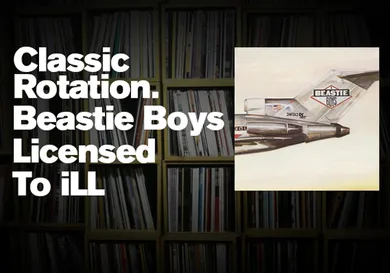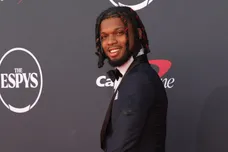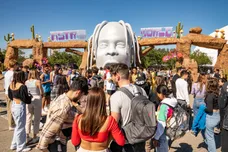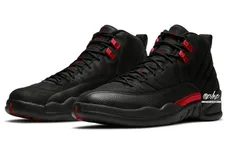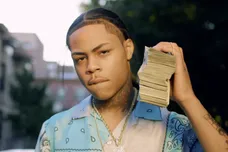Rap’s early origins, if we are being historically correct, were partially nurtured by punk and new wave, coming out of rebellious Manhattan kids (and those influenced by the music coming out of the area). With respect to Run DMC, rap and rock’s symbiosis started with icons like Afrika Bambaataa, Fab 5 Freddy, and Blondie, who would saunter out the first rap verse, on MTV, for suburbanite consumption.
By the time three white Jewish kids called the Beastie Boys (Mike Diamond as Mike D, Adam Yauch as MCA, and Adam Horowitz as Ad Rock) got into a studio with Rick Rubin, “Rapture” had been out. Bambaataa had teamed up with Sex Pistols fireplug Johnny Rotten. The Cold Crush Brothers had released a cut called “Punk Rock Rap.” There are occasional eye-rolls over Justin Timberlake, Eminem, and Robin Thicke being played on black radio. However, Phil Collins’ “In the Air Tonight” was played on R&B stations, while other white artists like The Clash, Depeche Mode, Human League being regularly played in the hood.
This prelude lined up a transition from punk to rap for the Beastie Boys, a former 4-piece, which once featured Kate Schellenbach on drums (who later joined Luscious Jackson, the first band on the Beasties’ Grand Royal Records – a nice turn around for the drummer, who was rumored to be nudged out of the group by Rick Rubin). The trio put out a then-experimental rap single called “Cooky Puss,” which became an underground New York hit. They gained the attention of Rubin, who had recently started Def Jam Recordings with Russell Simmons.
Starting with 12” singles “Rock Hard,” “Hold It Now Hit It,” "She's On It," and double A side “Paul Revere/The New Style,” the group set out the road. First backing Johnny Rotten’s post-Sex Pistols outfit, they moved on to open for Madonna’s “Like A Virgin” tour. Beastiemania took hold, and Rubin was already at work on the debut, Licensed to Ill.
Endless fictional thievery-referencing meta-track “Rhymin & Stealin” leads off the album, using the huge John Bonham drum sample from Led Zeppelin’s “When the Levee Breaks.” “The New Style,” from which Ad-Rock’s vocals were sampled by J-Dilla for “The New” on the classic Donuts and Pharcyde’s “Drop”, features more interesting references, notably about violent gunplay.
“Let me clear my throat
Kick it over here baby pop
And let all the fly skimmies feel the beat
Mmm...drop
Coolin' on the corner on a hot summer day
Just me, my posse and MCA
A lot of beer - a lot of girls - and a lot of cursing
Twenty-two automatic on my person
Got my hand in my pocket and my finger's on the trigger”
The woman-dogging “She’s Crafty” is one of the misogynistic cuts, with another Zeppelin sample. “Posse In Effect” contains a Joeski Love sample and MCA’s wittier set of rhymes:
“I got a girl in the Castle and one in the pagoda
You know I got rhymes like Abe Vigoda
I'm a Def Manhattan killer - a rhyme thriller
A mic in my hand (bust it) and a mouth full of Miller”
War’s classic “Low Rider” is perfectly sampled in “Slow Ride,” with Rubin adding percussion and heavy 808s. The cut is followed by the problematic “Girls,” a track only performed once (sandwiched in between a rendition of “Sabotage,” in 1995.) Knowing it was likely too far, they eventually apologized for the track, and, in effect, the album as a whole.
“Fight for Your Right (To Party!), an unintentionally massive, 80s hair rock, teenage delinquency record, put them on the permanent path to stardom. The iconic hook and video drove the album, but would have heavier ramifications shortly after the release. “No Sleep Til Brooklyn” takes from Motorhead’s “We Are the Road Crew” from No Sleep Till Hammersmith:
"Another plane, another train
Another bottle in the brain
Another girl, another fight
Another drive all night"
Hood favorite “Paul Revere” used backwards 808s drum patterns, thought to either by Run’s idea, or (per Run) a complete mistake turned into a dope track. Ad-Rock goes for the moon with a memorable and comedic line:
“The sheriff's after me for what I did to his daughter
I did it like this, I did it like that
I did it with a wiffleball bat”
“Hold It Now Hit It,” the album’s most interesting track due to its creative sample usage, was also of import for the fact that it was presented as a single, prior to Beastiemania. The song with the then-faceless artists enabled them to gain respectability from the jump. A prelude to what they would accomplish with the Dust Brothers on Paul’s Boutique, it featured samples from Doug E. Fresh, Bob James, Jimmy Castor, and Kool & the Gang.
Party record “Brass Monkey” (a drink comprised of rum, vodka, and orange juice or orange juice in a 40 ounce bottle of Old English) is still being played in college frat parties across America. Guitar stab driven “Slow and Low” was demoed by Run DMC originally. (This is likely the origin for ideas Rubin used in Jay-Z’s “99 Problems.”) High energy closer “Time to Get Ill,” runs similar to “Hold It Now…,” with plentiful samples, perhaps as accidental career foreshadowing.
In form and function, and with Run DMC’s incredible albums setting precedent, the classic Licensed to Ill was the prototype fusion album. Initially, Run DMC had to be coerced into utilizing rock elements, where has the Beastie arrived with punk rock credentials, allowing for a audibly distinguishable adaptation of rock’s nuances. Licensed to Ill stands as rap’s solidifiers, helping to cement the genre’s foundations. Aside from the misogyny and sixth year frat boy antics, the most surprising (and disturbing) points on the album are the lyrics filled with casual gun violence, which isn't always noted in discussions about the project. Of course, they became Buddhists -- unable to hurt a fly -- and environmentalists. Of course, they did.
There’s a narrative that says Rick Rubin masterminded the album, which is a somewhat dubious assumption, given the Beasties’ uses of playful wordplay and star appeal took them beyond the interesting production. (This is aside from the album’s split co-production credit, showing the group's very active role). In the background, “Fight for Your Right…” was shaped by personas Rubin created for the trio that none of them wanted to maintain going forward.
This idea (and that Rubin and Simmons likely insisted they carry on in character) actually progressed into a parting of ways for Def Jam and the Beasties, who both went on to spectacular careers. However, they would both have to admit, their temporary partnership pioneered something groundbreaking and irreversible. It’s possible that Eminem, a megastar known to be highly influenced by the Beasties, doesn’t make it out of Detroit without them. They busted down some doors, and stretched the genre over into new terrain. Neither can take that away.
